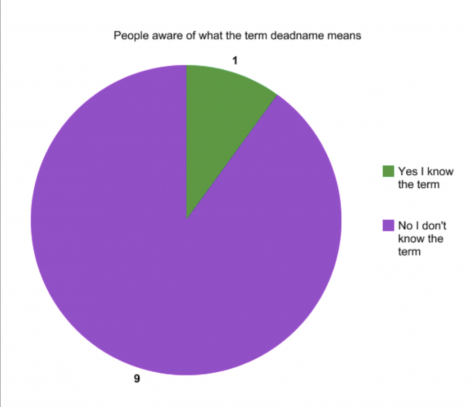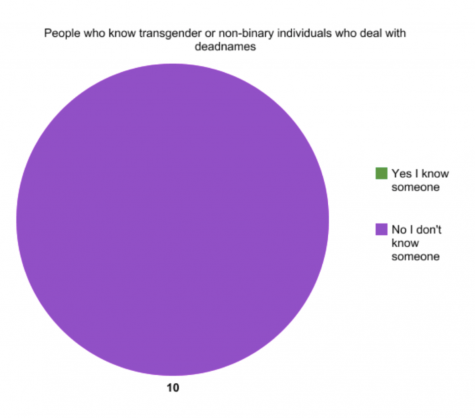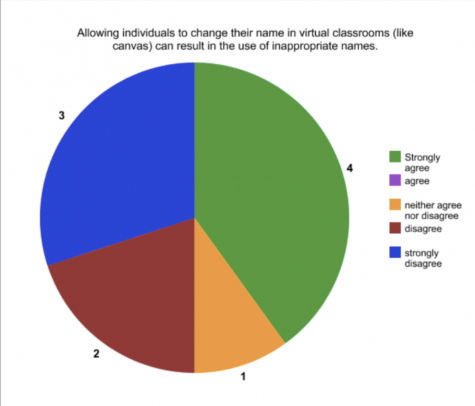Deadnaming and Misgendering
How have they affected Panther Creek's trans + nonbinary students?
October 20, 2020
Chances are when you look at whatever screen you use to access your virtual classrooms, the pixels you see broadcasting your identity to others accurately reflect the fundamental parts of it. If this is the case, you’re in the majority of Panther Creek students, and you’re probably cisgender, or cis– meaning you identify with the gender you were assigned at birth.
Students who aren’t cis, who are transgender (trans) and/or nonbinary (sometimes called nb or enby), have to deal with constantly being misgendered. One example of this is others using the wrong pronouns to refer to them. They also have to frequently face their deadname, a former name that a person no longer uses, if they have one. These instances are all too common in the online environment fostered by Google Meet, Google Classroom, Canvas, and other platforms used for virtual learning. Now that students aren’t able to be physically present in a classroom, unintentional misgendering and deadnaming are much more prevalent. One PCHS sophomore, who asked to remain anonymous, describes her experience with being deadnamed and misgendered as happening “pretty much every time in my four classes, especially because I’m not out yet. Teachers use names very often now as it’s hard to direct words to someone over meets,” she says, adding that she has “very rarely experienced it with people/groups I’m out to.” She tells us this differs from her in-person high school experience last year, “especially with teachers using names more often when doing things like reading the chat. Another aspect of being in person was sitting next to people I’m out to who’d use my preferred name and pronouns in conversation, which isn’t doable in a chatroom setting.”
One Panther Creek senior, also wishing to stay anonymous, adds that “There’s definitely feelings with being overlooked. I personally have not changed my name and as a result don’t have to deal with deadnames, but I can’t imagine how some trans folks feel having to see it in their Google Meets every day. But it is easier for my teachers to misgender me and for other people to misgender me because I have not been given a space to come out and say it. There’s no pin I can wear that might help me, there’s no shirt someone can see when I have my camera off. I’ve definitely also noticed that I’m much more sensitive to people using the wrong pronouns for me.” They go on to mention that “there are certain days where it completely ruins my mood. It’s hard to focus, I feel awful, and I usually get upset. My identity has become so inherently important to me, and there are days where being misgendered is enough to put me in tears. Even if someone apologized to me afterward, the initial feelings still stick and put me in a bad mood.”
“It’s a really poor feeling to be referred to by the wrong name/pronouns, and can contribute to dysphoria,” says the sophomore we heard from earlier. While the automated use of legal first names in virtual Wake County spaces is an annoyance to students who go by nicknames or middle names, it can be actively harmful to students who don’t want to be associated with given names that they no longer use. The sophomore points out a solution in the form of a Chrome extension called ‘Deadname Remover,’ which, as the name suggests, replaces a name with a different one wherever it might pop up on websites the user accesses. However, the extension has its limits, as it doesn’t affect the name other students see.
Currently, there are no options to universally change a student’s display name on Google Meet/Classroom or Canvas. Creating or enabling an option like this might have its faults, as it could potentially lead to impersonation or explicit names. However, most PCHS students are respectful of teachers and peers; the amount of students who misuse the ability would likely be low, and it’s a problem that’s easily dealt with. It’s likely that allowing students to change their display names on virtual learning platforms would do more good than harm. The senior we spoke with expressed their belief that “in a Google Meet, people should be able to change their nicknames so they can avoid being deadnamed– teachers do that in person, so why shouldn’t it be a thing online? It’s a simple change. If need be, you could also include pronouns with the nickname– I’ve had to do it for several of my school group chats and while I dislike it (I’m forced to be alienated), it stops me from being misgendered.”
In terms of other solutions for unintentional misgendering, Canvas has an option that institution administrators can enable, allowing students to add pronouns to their profile from a list selected by the admins. The option is disabled by default, and to PCNN’s knowledge, Wake County administrators have made no move to check the box enabling the feature.
While there isn’t much Wake County students can do about this, the two we talked with had some ideas for things anyone can do to be supportive of their trans/nonbinary peers on a smaller scale. The senior suggests that cis students can “educate themselves on their privileges, on our struggles, on our history, etc. Also, uplift trans voices! When someone says something is transphobic [prejudiced against transgender people], especially if they’re trans, back them up and support them. Call out transphobia where you can, correct misuse of people’s pronouns, etc. We face this sort of thing every day and will continue to face it every day, and cis students can play a role in helping us deal with it.” They went on to ask that everyone “respect people’s pronouns, and put your pronouns in your social media bios.”
The sophomore states “the one thing I wish is for everyone to be understanding and accepting of other peoples’ identities, as it matters a lot for people to feel their identity is valid as anyone else would. A big part of high school is figuring yourself out and everyone should be treated with respect in that regard.”





